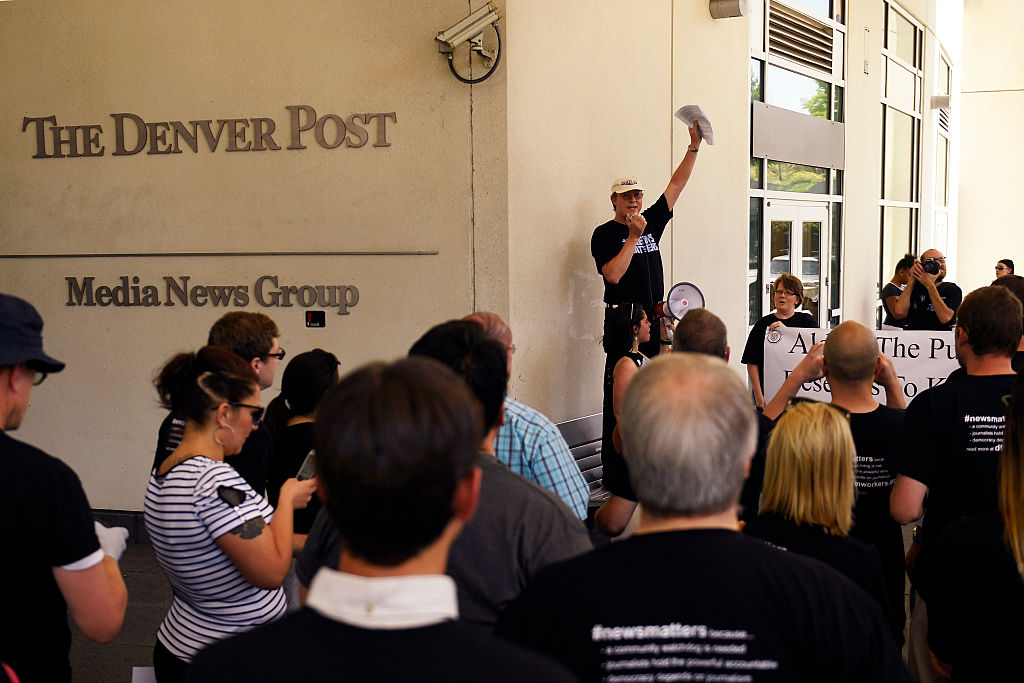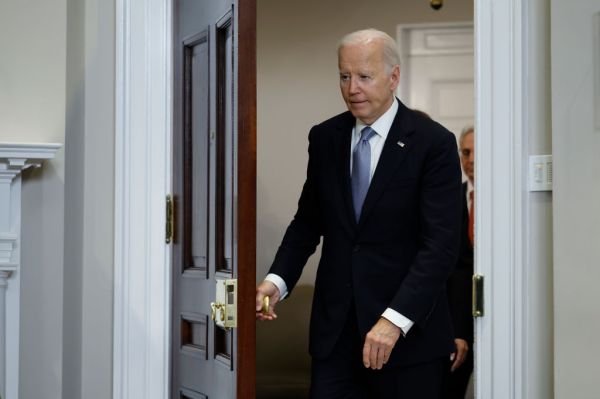Local news is in crisis.
What was once the lifeblood of the newspaper business—ad revenue—has collapsed, going from $49 billion in 2005 to an estimated $10 billion in 2020. Since that collapse began, more than 2,500—or about 25 percent—of the country’s newspapers have closed, according to a 2022 report by the Local News Initiative at Northwestern University, and total newsroom employment has declined by nearly 60 percent. More than 200 of the country’s 3,143 counties qualify as “news deserts,” meaning they have no access to credible local news. Many of the newspapers that remain run on shoestring budgets, with little meaningful coverage of local issues. Frequent layoffs are commonplace.
The net result in most communities is not just a decline in civic participation, but also a rise in political polarization and even a higher cost of living. One 2020 study found that, “Local newspapers hold their governments accountable, keeping municipal borrowing costs low and ultimately saving local taxpayers money.”
Yet amid the decline, some organizations are working to save what remains of local news, funneling money, business support, and reporting staff to local papers, investing in new, nonprofit publications, and exploring ways public policy can stave off the further erosion of local journalism. Will it be enough?
‘Too few reporters.’
Some organizations believe one answer lies in providing local newspapers with more reporters. Report for America (RFA), a nonprofit founded in 2017 to bring a Teach for America-like model of public service to local news, recruits journalists and places them in struggling local newsrooms across the country. It also pays a portion of their salary for two to three years while helping publications stand up fundraising efforts to sponsor the reporting position—this includes operating as newspapers’ fiscal sponsor to enable for-profit publications to accept tax-deductible donations. “Our hope upon hope is that at the end of that third year, newsrooms know enough about raising money, they’re getting good at it such that they can permanently pay the salary of that reporter,” Kim Kleman, the executive director of RFA, tells The Dispatch.
Since 2018, RFA has placed more than 600 journalists in 338 newsrooms in every state in the country, plus Guam and Puerto Rico (and a handful of international publications). RFA originally hoped to place 1,000 reporters in local newsrooms, but the pool of experienced journalists has continued to shrink as the industry has hemorrhaged jobs. “The heart of the problem is too few reporters,” Steve Waldman, president of the Rebuild Local News coalition and a co-founder of Report for America, tells The Dispatch.
But reporters who have been placed have provided a staffing lifeline. In Ouray County, Colorado, which has just over 5,000 residents, the Ouray County Plaindealer received its first of several RFA fellows in the summer of 2020. “I don’t know that we would have survived the pandemic without an extra reporter,” Erin McIntyre, the co-owner, co-editor, and co-published of the paper, tells The Dispatch.
McIntyre and her husband purchased the Plaindealer in 2019, after leaving their jobs—reporter and managing editor, respectively—at the much larger western Colorado paper the Grand Junction Daily Sentinel. The couple put in their time gaining experience at the Sentinel and thought they’d eventually move to a larger regional paper like the Denver Post. “When we saw people getting cut from these papers that had been purchased by hedge funds, we were like, ‘Wait, what way is up at this point?’”
So instead they took the ownership plunge, joining a long line of caretakers of the paper, which was originally founded in 1877. “We’re the only news source in the entire county,” McIntyre tells The Dispatch. “There’s no TV station. There’s not even a radio station that is based or that broadcasts here.” The reporting staff consisted of just the two of them plus their dog Walter (named after Walter Cronkite), and newspaper delivery is contracted out to a local family’s teenagers.
The first RFA member to join the Plaindealer, Liz Teitz, reported on local issues ranging from an out-of-control U.S. Forest Service-prescribed fire to coverage of a local housing shortage. “There’s a lot of misconceptions about small, local, rural weekly newspapers as not doing particularly rigorous journalism,” Teitz tells The Dispatch. “There’s something really special as a reporter to get to be covering a community and getting to know it over time, rather than being a national reporter and jumping onto different things at different times and coming in and out.” She stayed on as an RFA reporter with the paper for three years.
RFA also boosted the paper’s fundraising efforts. “Report for America gave us a tool with the matching funds to be able to go to the community and say, ‘Look, we’re resourceful, we already went out and got this matching money to be able to serve you, and now we need you guys to tell us you want to do more of this kind of work,’” McIntyre says. The community bought in. The first donors supporting the RFA position were actually the town’s class of third graders who donated the proceeds of their read-a-thon.
While many RFA corps members work with smaller local weeklies like the Plaindealer, others are working to revive an important beat: state and local papers covering federal issues through a regional lens. Orion Donovan Smith, a native of northwest Washington, joined the Spokesman-Review—a Spokane-based regional paper—through RFA, working full time as a reporter out of Washington, D.C.
An investigative story by Smith and another RFA journalist covered the botched rollout of a new electronic health records-keeping system the Department of Veterans Affairs piloted at VA facilities in the Spokane area. The failures delayed care for thousands of veterans, harming dozens and leading to the deaths of four people. “We know that impact not because I’m a genius reporter but because the Spokesman-Review and Report for America decided to have somebody pay attention to the federal government’s impact on the Inland Northwest,” Smith tells The Dispatch. Smith’s coverage won the 2022 “Feddie” reporting award from the National Press Foundation.
The Spokesman-Review hired Smith outright as a D.C.-based regional reporter, but most RFA papers can’t maintain those positions on their own—23 percent of program alumni are still working at their original host newsrooms, according to RFA. That’s partly why some organizations working to revive local news are focusing on different models.
A nonprofit future.
Over the last decade, a growing number of state and local publications have cropped up as new, nonprofit newsrooms. Early pioneers like VTDigger—now Vermont’s paper of record—and the Texas Tribune, both founded in 2009, helped prove that nonprofits could thrive in state and local news markets. There are now more than 400 nonprofit news organizations across the country.
Anne Galloway started the Digger after she was laid off by a local paper following the Great Recession. But she soon found the community was willing to invest in serious journalism. “We were really always digging for the real story behind the story,” Galloway tells The Dispatch. “People loved that and responded by giving us money, whether it was underwriting or membership.” The Digger has become an industry model for its mix of revenue sources and early business-side hires to grow. Most of the Digger’s revenue comes from foundation grants and major gifts, individual memberships and donations, and corporate sponsorship. The Texas Tribune has a similar revenue mix and even hosts an annual ideas festival to help fund the publication—events accounted for 17 percent of its annual revenue last year.
“We think the nonprofit model is a really promising model for how to address the local news crisis in many markets because it opens up new lines of revenue that are very promising and are demonstrating that they can work,” Sarabeth Berman, CEO of the American Journalism Project (AJP), tells The Dispatch. AJP is a venture philanthropy firm founded in 2019 that fundraises nationally and offers grants and support to newsrooms throughout the country designed to boost their business operations.
AJP’s first round of grantees saw a nearly 500 percent return on investment in their fundraising efforts, according to Berman. AJP gave VTDigger a 3-year $900,000 grant in 2020 for the publication’s business operations. Last year, the Digger’s annual revenue was $3.7 million—up from $2.1 million in 2019.
Meanwhile, policy-oriented foundations like Arnold Ventures—run by billionaires John and Laura Arnold—also see the value in supporting news organizations as an important way to further their policy reform goals. “No matter what your issue is, if it’s education, criminal justice, health care, etc., your second issue should be journalism because then journalism helps inform and enlighten the masses including the policymakers,” Jeff Cohen, the head of Arnold Ventures’ journalism giving portfolio, tells The Dispatch. Arnold Ventures has distributed more than $50 million in grants to support journalism projects including nearly $10 million to AJP—Arnold was a founding member of the project. (All of Arnold’s grants to publications are for general operating support, not contingent on news coverage related to the group’s policy positions.)
Other organizations such as the Knight Foundation, the Emerson Collective, and the Institute for Nonprofit News, among others, are performing similar work. But the nonprofit model likely won’t be a silver bullet for local news’ woes.
“Nothing scales like capitalism, and nonprofits don’t replicate themselves,” Richard Tofel, the former president of ProPublica, told Margaret Sullivan in her book Ghosting the News. A 2019 Duke University study analyzed a sample of 100 communities across the U.S. to understand what types of outlets produce the most original reporting. After examining 16,000 stories, researchers found that local newspapers only accounted for a quarter of the outlets but almost 50 percent of the original news stories, far outperforming television, radio, and digital-only outlets. “What are we doing about the 6,000 or so existing newspapers?” Waldman asks. “It’s great that we have 400 new nonprofits, but if we don’t deal with improving both the quality and the economic health of the 6,000 newspapers, we’re really only going to scratch the surface of the problem.”
Is Uncle Sam an answer?
Most journalists are rightly skeptical of the prospect of public funding—they make a living publishing stories that often run afoul of elected officials. But some argue that well-designed policies can both support local newsrooms and protect publications from government meddling.
Waldman started the Rebuild Local News Coalition—a group advocating for federal and state policies to support local news—after he became convinced “the local news crisis was such a severe threat to democracy and to communities and the country that public policy had to be a piece of the puzzle.”
The coalition helps analyze and promote a growing menu of public policy proposals. They include payroll tax credits for hiring and retaining local reporters; credits or vouchers for local news subscriptions, and direct subsidies to local newsrooms via an independent government body, among others.
Some are gaining traction. In Congress, Democratic Rep. Ann Kirkpatrick and Republican Rep. Dan Newhouse introduced the Local Journalism Sustainability Act in 2021, which includes tax credits for subscribers and small businesses advertising with local papers as well as payroll tax credits for local outlets hiring reporters. The latter actually passed the House as part of the Build Back Better legislative package but didn’t make it through the Senate.
Last month, Rep. Claudia Tenney—a New York Republican and former owner and publisher of a local weekly paper—and Democratic Rep. Suzan DelBene introduced a bill allowing small businesses to claim up to a $5,000 tax credit one year and then $2,500 in the next four years for advertising with local news organizations. News outlets could claim up to a $25,000 refundable payroll tax credit per local journalist they have on staff in the first year and then $15,000 in the next four years. “The best bang for the buck, the most direct thing, probably is the payroll tax credit,” Waldman tells The Dispatch. “The money is toward employment of local reporters. The incentives are in the right place. If you cut back, you get less. If you grow up more reporters, you end up getting more.”
State governments are also exploring new policies to support local newsrooms. New Jersey launched the Civic Info Consortium—an independent, government-funded nonprofit that distributes grants to news organizations and other civic community groups in news deserts. Washington introduced a 10-year exemption to the business and occupations tax for newspaper publishers. And several states including New Mexico and California have created fellowship programs similar to RFA that place journalists in local newsrooms.
It’s all evidence that rejuvenating local news—and restoring some of the civic value and trust lost when local news outlets die off—will likely require an anything-and-everything approach.
“Investing in established local news outlets is a really important way to rebuild some of that trust,” Smith, of the Spokesman-Review, tells The Dispatch. Unlike some national outlets, people of all political stripes read their local newspaper. “They trust a local paper even if they don’t always agree with what we write.”









Please note that we at The Dispatch hold ourselves, our work, and our commenters to a higher standard than other places on the internet. We welcome comments that foster genuine debate or discussion—including comments critical of us or our work—but responses that include ad hominem attacks on fellow Dispatch members or are intended to stoke fear and anger may be moderated.